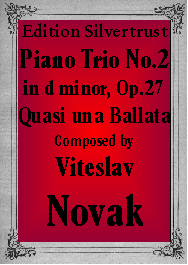Presents
Vitĕzslav Novák
Piano Trio No.2 in d minor, Op.27-Quasi una Ballata
 Vitĕzslav Novák's
Piano Trio No.2, Quasi una Ballata, was written at a time (1902) when his allegiance was torn
between two different musical camps. He was still attracted to the use of folk
melody as was advocated by the older and more conservative generation of Czech
composers such as Dvorak, but he was also attracted to the tonal modernism which
was emerging from fin du siecle Europe. This conflict caused him considerable
anguish and he was later to write that in many ways, the trio was
autobiographical.
Vitĕzslav Novák's
Piano Trio No.2, Quasi una Ballata, was written at a time (1902) when his allegiance was torn
between two different musical camps. He was still attracted to the use of folk
melody as was advocated by the older and more conservative generation of Czech
composers such as Dvorak, but he was also attracted to the tonal modernism which
was emerging from fin du siecle Europe. This conflict caused him considerable
anguish and he was later to write that in many ways, the trio was
autobiographical.
Vitĕzslav Novák (1870-1949) was a leading proponent of the Czech nationalism in music in the generation after Dvorak and Smetana. However it seemed unlikely that he would become a musician having begun by hating music as a result of being brutally forced to study the violin and the piano as a young child. But a fascination for composition, which he discovered in his teens, led to his decision to enter the Prague Conservatory, where he studied with Dvorak among others. Dvorak's example of using Czech folk melody in his music to foster the nationalist cause at a time when the Czech and Slovak peoples were seeking statehood from Austria encouraged the young composer to follow this path. After graduating from the Conservatory in 1896, he traveled to eastern Moravia and Slovakia where the local folk melodies he found served as a source of inspiration for him.
Although the trio is written in one movement, hence a ballad, it nonetheless follows traditional classical structure in that it has four succinct episodes or sections. It begins with an introductory Andante tragico, full of pessimism and though tonally advanced for the time, there are still traces, mostly rhythmical, of Moravian folk songs. This is followed by an Allegro which has a heroic theme for its main subject but it too is tinged with a sense of the tragic. Next comes a sarcastic scherzo, Allegro burlesco. In the fourth section, the Andante tragico is reprised, this time followed by a very dramatic Allegro which leads to a somber and funereal coda.
This trio, along with the Dumky of Dvorak and the Smetana, make up the foundation of the piano trio literature in the Czech Republic, yet sadly, it has been rarely if ever performed abroad. We hope professional groups will investigate and program this extraordinary work, which amateurs will also find worthwhile.
Parts $29.95